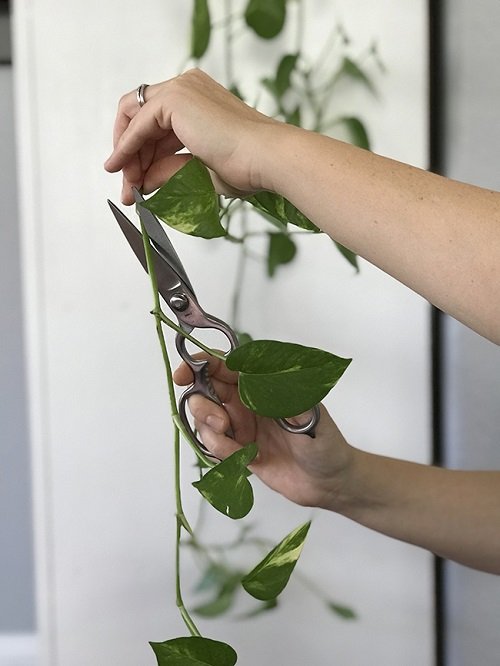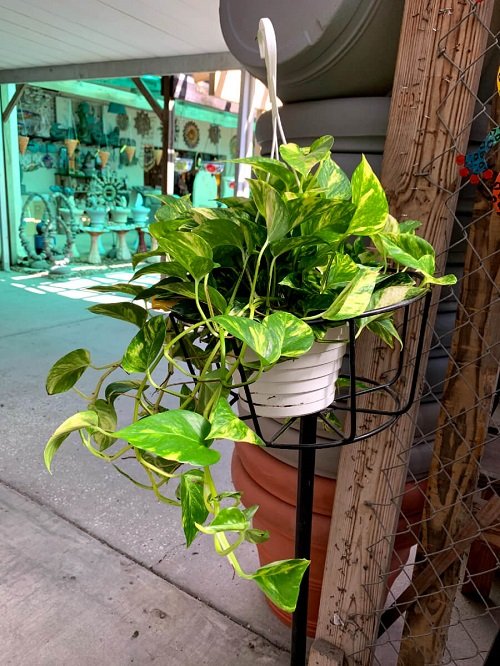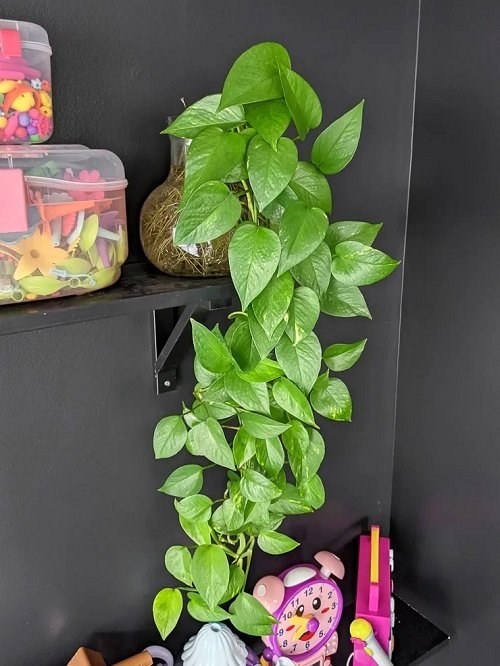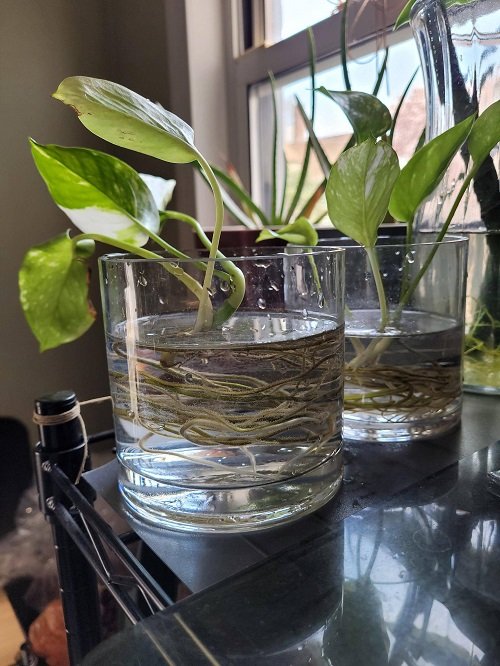Pothos Plant Care is simple and effortless. This beautiful houseplant not only spreads a green hue indoors but also purifies the air.
Here’s all you need to know about Pothos Plant Care in detail that will help you to maintain this evergreen plant with ease!
Family: Araceae
Botanical Name: Epipremnum aureum
Plant Type: Climber, Trailing vine
Foliage Type: Evergreen
Propagation: Pothos plant can be propagated from cuttings. You can root it in water or soil.
Toxicity: Mildly toxic to cats and dogs, it contains insoluble calcium oxalates. Ingestion may cause vomiting, irritation in the mouth, and difficulty in swallowing, which subsides after a few hours.
Popular Pothos Varieties
Before we dive deep into Pothos Plant Care, let’s have a look at the best types of pothos you must grow.
- Golden Pothos: Also known as the devil’s ivy, this is the most common variety of pothos that has heart-shaped leaves with a green and golden hue.
- Silver Satin Pothos: Just like the name, the leaves of silver satin pothos are satin green with silver streaks. Other names of this plant are Silver Philodendron, Silk Pothos, and Satin Pothos.
- Pearls and Jade Pothos: Not different from golden pothos but have darker green leaves.
- Neon Pothos: This kind of pothos is very similar to golden pothos but with a touch of dark neon foliage.
- Marble Queen Pothos: This variety of pothos has white variegation. Due to this, its growth is slower than golden pothos.
- Cebu Blue Pothos: Cebu blue pothos looks quite attractive with silver shiny blue leaves.
- Manjula Pothos: Curly heart-shaped leaves of this plant look attractive with creamy-white and green variegation.
Apart from these, Marble Queen Pothos (Epipremnum aureum ‘Marble Queen’), Jade Pothos (Epipremnum aureum ‘Jade’), Pearls and Jade Pothos (Scindapsus aureus ‘Pearls and Jade’), N’ Joy Pothos (Epipremnum pinnatum ‘N’ Joy’), and Snow Queen Pothos (Epipremnum pinnatum ‘Snow Queen’) are also great options.
To check out in detail, read our article on pothos varieties here
Pothos Plant Information
Before we talk about Pothos Plant Care, it is important to know about the plant!
Pothos (Epipremnum aureum) plant originated somewhere in Oceania or Southeastern Asia. It is commonly known as Devil’s ivy, Golden pothos, Ceylon creeper, and Money plant. This is a popular indoor plant, and you can find it in homes, hospital premises, offices, and almost everywhere. People love it for its attractive foliage, ease of care, and its ability to tolerate low-light conditions.
How Long Pothos Can Grow Indoors?
As a houseplant, it can be 5-10 feet long. Support it with string or a pole to let it grow upward, or plant that in a window box or hanging basket and see the variegated golden climber dangling down with style.
Propagating Pothos

Propagating pothos plant is very easy and can be done using cuttings and division. Pothos Plant Care also depends a lot on how you have planted it in the first place.
- To propagate a pothos, start by cutting a stem just below a leaf node.
- Next, remove all of the leaves from the bottom half of the stem and place the stem in a glass of water.
- Make sure that the water is changed every few days to keep it fresh. The stem should start to form new roots in 1-2 weeks.
- Once the roots are about an inch long, you can transplant the stem into a pot of soil.
- Keep the soil moist and make sure the plant receives bright indirect sunlight. Your Pothos stem should start to grow new leaves and vines within a few weeks.
Note: You can also propagate the cuttings directly in the soil.
Read our detailed article on pothos propagation here
Requirements for Growing Pothos
Location
Location plays a vital role in Pothos Plant Care. These plants can thrive in soft indoor light. It means indirect, bright sunlight is enough for the growth of pothos.
Rotate the plant regularly so each part can get sufficient exposure. Keep it away from harsh afternoon sunlight at all costs. Also, 2-3 hours of direct exposure to the mild morning sun will be great!
Soil
Another important point in Pothos Plant Care is the type of growing medium.
The best soil type for Pothos is a well-draining, organic-rich mix. A combination of equal parts perlite, peat moss, and potting soil is ideal.
Make sure the potting soil is specifically designed for houseplants, as they provide the best nutrition for your plant.
Watering
How you water the plant is also crucial in Pothos Plant Care.
Outdoor pothos plant prefers growing in slightly moist soil but forgives irregular watering and occasional drought. However, indoor Pothos Plant Care is different, and you need to be careful when it comes to watering.
When it comes to watering pothos, you can estimate how thirsty your plant is by just giving attention to the leaves and soil. Like with many indoor plants, don’t water it until the topsoil feels dry to the touch.
Frequent watering can rot the roots, so avoid watering the plant daily.
Temperature and Humidity
Another vital factor in Pothos Plant Care is the temperature range. Pothos are tropical plants and prefer temperatures between 60-85°F (15-30°C). Normal room temperature is perfect for this houseplant.
Pothos like high humidity, but it’s one of those indoor plants that can bear dry air very efficiently, which is why it is considered one of the best low-maintenance houseplants. You can keep its pot on a pebble tray filled with water.
Support
Supporting the plant is also an important factor in Pothos Plant Care.
While you can allow the pothos vines to trail down beautifully, you shouldn’t do this if you want big pothos leaves.
One of the secrets of growing pothos with giant leaves is providing support to the vine so that it trains to grow up. You can use a moss pole or rope for this purpose! If you want to grow pothos with big leaves–don’t miss reading this guide here.
Pothos Plant Care
Fertilizer
When it comes to Pothos Plant Care, frequent fertilization is not necessarily needed. But you can feed it with a balanced liquid fertilizer like 20-20-20, once in 4-6 weeks during the growing season.
If you’re feeding in a weak dose (1/2 or 1/4 of the recommended strength of the fertilizer manufacturer), you can do this once in 2-3 weeks.
If you notice leaves burnt from the edges, this can be a sign of overfertilization. Follow these techniques to help your plant.
Repotting
Re-potting is another important factor in Pothos Plant Care. Remember, pothos grow well in a slightly root-bound state, but you’ll need to re-pot it soon if you see the plant outgrowing the current pot, one of the signs is when you observe roots crowding the soil. Carefully shift the plant in one size bigger pot.
The best time to repot pothos is when the weather is warm, more specifically in spring or summer. In a frost-free, subtropical, or tropical climate, do it anytime!
- Tie up the long trailing stems so that they won’t come in the way during the transplanting.
- Choose the diameter of the pot 2 inches larger than the previous one. For example, if a pothos was planted in a pot of 6 inches in diameter, re-pot it in a pot ranging from 8-10 inches.
Pruning
Another crucial point in Pothos Plant Care is pruning.
Remove dead, decayed, and yellowing stems & leaves regularly. If the plant is leggy and shows a lack of growth, simply trim back the stems by either pruning or pinching up to one or two nodes.
You can also cut back leafless branches to the soil level to rejuvenate the growth. Also, if you want to multiply your plant or need to reshape it, you’ll need to prune stems.
If you want to make your pothos fuller, replant the pruned cuttings in the same pot; once they’ll root, your plant will start looking full and lush. All this will ensure your Pothos Plant Care goes in the right direction. For more such pothos growing tricks, click here!
Right Time to Prune Pothos
Well, you can prune anytime during the growing season, every few weeks. A little bit of regular pinching and pruning makes pothos fuller.
Pests and Diseases
This is the point you just can’t ignore during Pothos Plant Care!
Common garden pests such as mealybugs, spider mites, and scale insects might bother it. The best way to get rid of them is by applying a cotton ball soaked in alcohol directly to the affected site. You can also use insecticidal soap to remove them.
The most common disease is phytophthora root rot. It causes the foliage to turn black and brown; stems of the pothos remain safe as it only affects roots and leaves.
As this disease is favored by high soil moisture, you can prevent it by avoiding overwatering. Pruning the affected part of the plant is the last resort.
Take care of these points for the best Pothos Plant Care.
Growing Pothos in Water
Pothos Plant Care, when grown in water, is super easy. Plant it in water to add greenery to your tabletops, desks, and shelves. It’s a part of our list of similar houseplants.
Plant it in fish bowls, glass jars, terrariums, and vases without meddling in the mess of soil. If you’re a creative person, get some test tubes or cool mason jars to grow them. All this will ensure the right Pothos Plant Care.
For more details, check out our article on planting pothos in the water here
Pothos Plant Indoor Uses
Now that you know about the right Pothos Plant Care, let’s have a look at its uses!
- Golden pothos or any variety of this plant can easily beautify your interior with lush green variegated leaves.
- Plant it in a hanging basket to enjoy easy, low-maintenance vines cascading down.
- You can also grow it in water in fish bowls, mason jars, and cool glass containers.
Pothos Plant Benefits
If you are going to follow our tips on Pothos Plant Care, then it will help you reap its benefits to the fullest!
- This plant is a natural air purifier. It removes formaldehyde, benzene, and carbon monoxide, which has been proven in various studies.
- After spending hours in front of the computer screen, your eyes get tired and need some relief; you can treat your eyes by just staring at the pothos plant since it will act as an eye coolant. According to a Japanese study, the pothos plant has a calming effect on the mind.
- It’s believed in Feng shui & Vastu that the pothos plant brings luck and prosperity. We also added it to our list of money-attracting plants; check it out here.
- To learn more about proven golden pothos benefits, read this article.







